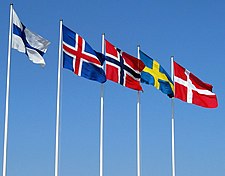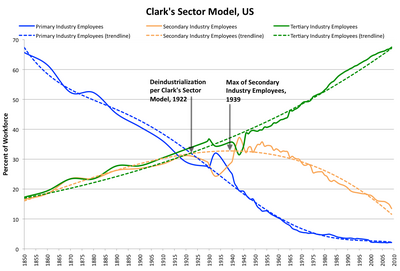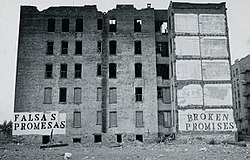The Scandinavian countries were all monarchies, with Finland and Iceland becoming republics in the 20th century. Currently, the Nordic countries have been described as being highly democratic.
Although there are significant differences among the Nordic countries,
they all share some common traits. These include support for a universalist welfare state aimed specifically at enhancing individual autonomy and promoting social mobility; a corporatist
system involving a tripartite arrangement where representatives of
labor and employers negotiate wages and labor market policy mediated by
the government; and a commitment to private ownership (with some caveats), a mixed economy, and free trade.
Each of the Nordic countries has its own economic and social models, sometimes with large differences from its neighbours. As of 2018, all of the Nordic countries rank highly on the Inequality-adjusted HDI and the Global Peace Index.
Each of the Nordic countries has its own economic and social models, sometimes with large differences from its neighbours. As of 2018, all of the Nordic countries rank highly on the Inequality-adjusted HDI and the Global Peace Index.
Overview
"The Nordic Model – Embracing globalization and sharing risks" characterises the system as follows:
- An elaborate social safety net, in addition to public services such as free education and universal healthcare in a largely tax-funded system.
- Strong property rights, contract enforcement and overall ease of doing business.
- Public pension plans.
- Free trade combined with collective risk sharing (social programs, labour market institutions) which has provided a form of protection against the risks associated with economic openness.
- Little product market regulation. Nordic countries rank very high in product market freedom according to OECD rankings.
- Low levels of corruption. In Transparency International's 2015 Corruption Perceptions Index, Denmark, Finland, Sweden and Norway were ranked among the top 10 least corrupt of the 167 countries evaluated.
- High percentage of workers belonging to a labour union. In 2013, labour union density was 88% in Iceland, 69% in Denmark, 67% in Sweden, 66% in Finland and 51% in Norway. In comparison, labour union density was 18% in Germany, 11% in the United States and 8% in France. The lower union density in Norway is mainly explained by the absence of a Ghent system since 1938. In contrast, Denmark, Finland and Sweden all have union-run unemployment funds.
- A partnership between employers, trade unions and the government, whereby these social partners negotiate the terms to regulating the workplace among themselves, rather than the terms being imposed by law. Sweden has decentralised wage co-ordination while Finland is ranked the least flexible. The changing economic conditions have given rise to fear among workers as well as resistance by trade unions in regards to reforms. At the same time, reforms and favourable economic development seem to have reduced unemployment, which has traditionally been higher. Denmark's Social Democrats managed to push through reforms in 1994 and 1996.
- The United Nations World Happiness Reports show that the happiest nations are concentrated in Northern Europe. The Nordics ranked highest on the metrics of real GDP per capita, healthy life expectancy, having someone to count on, perceived freedom to make life choices, generosity and freedom from corruption. The Nordic countries place in the top 10 of the World Happiness Report 2018, with Finland and Norway taking the top spots.
- The Nordic countries received the highest ranking for protecting workers rights on the International Trade Union Confederation's 2014 Global Rights Index, with Denmark being the only nation to receive a perfect score.
- Sweden at 56.6% of GDP, Denmark at 51.7% and Finland at 48.6% reflect very high public spending. One key reason for public spending is the large number of public employees. These employees work in various fields including education, healthcare and for the government itself. They often have greater job security and make up around a third of the workforce (more than 38% in Denmark). Public spending in social transfers such as unemployment benefits and early-retirement programmes is high. In 2001, the wage-based unemployment benefits were around 90% of wage in Denmark and 80% in Sweden, compared to 75% in the Netherlands and 60% in Germany. The unemployed were also able to receive benefits several years before reductions, compared to quick benefit reduction in other countries.
- Public expenditure for health and education is significantly higher in Denmark, Sweden, and Norway in comparison to the OECD average.
- Overall tax burdens (as a percentage of GDP) are high: Sweden (44.1%), Denmark (45.9%) and Finland (44.1%). The Nordic countries have relatively flat tax rates, meaning that even those with medium and low incomes are taxed at relatively high levels.
Aspects
Labor market policy
The Nordic countries share active labor market policies as part of a corporatist
economic model intended to reduce conflict between labor and the
interests of capital. The corporatist system is most extensive in Sweden
and Norway, where employer federations and labor representatives
bargain at the national level mediated by the government. Labor market
interventions are aimed at providing job retraining and relocation.
The Nordic labor market is flexible, with laws making it easy for
employers to hire and shed workers or introduce labor-saving
technology. To mitigate the negative effect on workers, the government
labor market policies are designed to provide generous social welfare,
job retraining and relocation to limit any conflicts between capital and
labor that might arise from this process.
Economic system
The Nordic model is underpinned by a free market capitalist economic system that features high degrees of private ownership with the exception of Norway, which includes a large number of state-owned enterprises and state ownership in publicly listed firms.
The Nordic model is described as a system of competitive
capitalism combined with a large percentage of the population employed
by the public sector (roughly 30% of the work force). In 2013, The Economist
described its countries as "stout free-traders who resist the
temptation to intervene even to protect iconic companies" while also
looking for ways to temper capitalism's harsher effects, and declared
that the Nordic countries "are probably the best-governed in the world".
Some economists have referred to the Nordic economic model as a form of
"cuddly" capitalism, with low levels of inequality, generous welfare
states and reduced concentration of top incomes and contrast it with the
more "cut-throat" capitalism of the United States, which has high levels of inequality and a larger concentration of top incomes.
Beginning in the 1990s, the Swedish economy pursued neoliberal reforms that reduced the role of the public sector, leading to the fastest growth in inequality of any OECD economy. However, Sweden's income inequality still remains lower than most other countries.
Norway's particularities
The
state of Norway has ownership stakes in many of the country's largest
publicly listed companies, owning 37% of the Oslo stockmarket and operating the country's largest non-listed companies including Equinor and Statkraft. The Economist
reports that "after the second world war the government nationalised
all German business interests in Norway and ended up owning 44% of Norsk
Hydro's shares. The formula of controlling business through shares
rather than regulation seemed to work well, so the government used it
wherever possible. 'We invented the Chinese way of doing things before the Chinese', says Torger Reve of the Norwegian Business School".
The government also operates a sovereign wealth fund, the Government Pension Fund of Norway—whose
partial objective is to prepare Norway for a post-oil future, but
"unusually among oil-producing nations, it is also a big advocate of
human rights—and a powerful one, thanks to its control of the Nobel
peace prize".
Norway is the only major economy in the West where younger
generations are getting richer, with a 13% increase in disposable income
for 2018, bucking the trend seen in other Western nations of Millennials becoming poorer than the generations which came before.
Nordic welfare model
The Nordic welfare model refers to the welfare policies
of the Nordic countries, which also tie into their labor market
policies. The Nordic model of welfare is distinguished from other types
of welfare states by its emphasis on maximizing labor force
participation, promoting gender equality, egalitarian and extensive benefit levels, the large magnitude of income redistribution and liberal use of expansionary fiscal policy.
While there are differences among the Nordic countries, they all
share a broad commitment to social cohesion, a universal nature of
welfare provision in order to safeguard individualism by providing
protection for vulnerable individuals and groups in society and
maximizing public participation in social decision-making. It is
characterized by flexibility and openness to innovation in the provision
of welfare. The Nordic welfare systems are mainly funded through taxation.
Despite the common values, the Nordic countries take different
approaches to the practical administration of the welfare state. Denmark
features a high degree of private sector provision of public services
and welfare, alongside an assimilation immigration policy. Iceland's
welfare model is based on a "welfare-to-work" model while part of Finland's welfare state includes the voluntary sector playing a significant role in providing care for the elderly. Norway relies most extensively on public provision of welfare.
Poverty reduction
The Nordic model has been successful at significantly reducing poverty.
In 2011, poverty rates before taking into account the effects of taxes
and transfers stood at 24.7% in Denmark, 31.9% in Finland, 21.6% in
Iceland, 25.6% in Norway and 26.5% in Sweden. After accounting for taxes
and transfers, the poverty rates for the same year became 6%, 7.5%,
5.7%, 7.7% and 9.7% respectively, for an average reduction of 18.7 p.p.
Compared to the United States, which has a poverty level pre-tax of
28.3% and post-tax of 17.4% for a reduction of 10.9 p.p., the effects of
tax and transfers on poverty in all the Nordic countries are
substantially bigger.
However, in comparison to France (27 p.p. reduction) and Germany (24.2
p.p. reduction) the taxes and transfers in the Nordic countries are
smaller on average.
Religion as a factor
Scandinavian countries have Lutheranism
as their main religion. Schroder argues that Lutheranism promotes the
idea of a nationwide community of believers and it promotes state
involvement in economic and social life. This allows nationwide welfare
solidarity and economic coordination. Currently, a large number of Scandinavians have been described as being irreligious.
Reception
The Nordic model has been positively received by some American politicians and political commentators. Jerry Mander has likened the Nordic model to a kind of "hybrid" system which features a blend of capitalist economics with socialist values, representing an alternative to American-style capitalism. Senator Bernie Sanders
(I-VT) has pointed to Scandinavia and the Nordic model as something the
United States can learn from, in particular with respect to the
benefits and social protections the Nordic model affords workers and its
provision of universal healthcare. According to Naomi Klein, former Soviet leader Mikhail Gorbachev sought to move the Soviet Union
in a similar direction to the Nordic system, combining free markets
with a social safety net, but still retaining public ownership of key
sectors of the economy—ingredients that he believed would transform the
Soviet Union into "a socialist beacon for all mankind".
The Nordic model has also been positively received by various
social scientists and economists. American professor of sociology and
political science Lane Kenworthy
advocates for the United States to make a gradual transition toward a
social democracy similar to those of the Nordic countries, defining
social democracy as such: "The idea behind social democracy was to make
capitalism better. There is disagreement about how exactly to do that,
and others might think the proposals in my book aren't true social
democracy. But I think of it as a commitment to use government to make
life better for people in a capitalist economy. To a large extent, that
consists of using public insurance programs—government transfers and
services". Nobel Prize-winning economist Joseph Stiglitz
has noted that there is higher social mobility in the Scandinavian
countries than in the United States and argues that Scandinavia is now
the land of opportunity that the United States once was. American author Ann Jones, who lived in Norway for four years, contends that "the Nordic countries give their populations freedom from the market by using capitalism as a tool to benefit everyone" whereas in the United States "neoliberal
politics puts the foxes in charge of the henhouse, and capitalists have
used the wealth generated by their enterprises (as well as financial
and political manipulations) to capture the state and pluck the
chickens".
Economist Jeffrey Sachs
is a proponent of the Nordic model, having pointed out that the Nordic
model is "the proof that modern capitalism can be combined with decency,
fairness, trust, honesty, and environmental sustainability".
The Nordic combination of extensive public provision of welfare and a culture of individualism has been described by Lars Trägårdh of Ersta Sköndal University College as "statist individualism".
A 2016 survey by the think tank Israel Democracy Institute found that nearly 60 percent of Israeli Jews preferred a "Scandinavian model" economy, with high taxes and a robust welfare state.
Misconceptions
George Lakey, author of Viking Economics, asserts that Americans generally misunderstand the nature of the Nordic "welfare state":
Americans imagine that "welfare state" means the U.S. welfare system on steroids. Actually, the Nordics scrapped their American-style welfare system at least 60 years ago, and substituted universal services, which means everyone—rich and poor—gets free higher education, free medical services, free eldercare, etc.
In his role as economic adviser to Poland and Yugoslavia in their
post-socialist transitional period, Jeffrey Sachs noted that the
specific forms of Western-style capitalism such as Swedish-style social
democracy and Thatcherite liberalism are virtually identical:
The eastern countries must reject any lingering ideas about a “third way”, such as a chimerical “market socialism” based on public ownership or worker self-management, and go straight for a western-style market economy...The main debate in economic reform should therefore be about the means of transition, not the ends. Eastern Europe will still argue over the ends: for example, whether to aim for Swedish-style social democracy or Thatcherite liberalism. But that can wait. Sweden and Britain alike have nearly complete private ownership, private financial markets and active labour markets. Eastern Europe today [in 1990] has none of these institutions; for it, the alternative models of Western Europe are almost identical.
In a speech at Harvard's Kennedy School of Government, Danish Prime Minister Lars Løkke Rasmussen
addressed the American misconception that the Nordic model is a form of
socialism: "I know that some people in the US associate the Nordic
model with some sort of socialism. Therefore, I would like to make one
thing clear. Denmark is far from a socialist planned economy. Denmark is
a market economy".
Criticism
Socialist economists John Roemer and Pranab Bardhan criticize Nordic-style social democracy for its questionable effectiveness in promoting relative egalitarianism as well as its sustainability. They point out that Nordic social democracy requires a strong labor movement
to sustain the heavy redistribution required, arguing that it is
idealistic to think similar levels of redistribution can be accomplished
in countries with weaker labor movements. They note that even in the
Scandinavian countries social democracy has been in decline since the
weakening of the labor movement in the early 1990s, arguing that the
sustainability of social democracy is limited. Roemer and Bardham argue
that establishing a market socialist
economy by changing enterprise ownership would be more effective than
social democratic redistribution at promoting egalitarian outcomes,
particularly in countries with weak labor movements.
Historian Guðmundur Jónsson argues that it would be inaccurate to include Iceland in one aspect of the Nordic model, that of consensus democracy.
He writes that "Icelandic democracy is better described as more
adversarial than consensual in style and practice. The labour market was
rife with conflict and strikes more frequent than in Europe, resulting
in strained government–trade union relationship. Secondly, Iceland did
not share the Nordic tradition of power-sharing or corporatism as
regards labour market policies or macro-economic policy management,
primarily because of the weakness of Social Democrats and the Left in
general. Thirdly, the legislative process did not show a strong tendency
towards consensus-building between government and opposition with
regard to government seeking consultation or support for key
legislation. Fourthly, the political style in legislative procedures and
public debate in general tended to be adversarial rather than
consensual in nature".
In their paper "The Scandinavian Fantasy: The Sources of
Intergeneration Mobility in Denmark and the U.S.", Rasmus Landersøn and
James J. Heckman compared American and Danish social mobility and found
that social mobility is not as high as figures might suggest in the
Nordic countries. When looking exclusively at wages (before taxes and
transfers), Danish and American social mobility are very similar. It is
only after taxes and transfers are taken into account that Danish social
mobility improves, indicating that Danish economic redistribution
policies simply give the impression of greater mobility. Additionally,
Denmark's greater investment in public education did not improve
educational mobility significantly, meaning children of non-college
educated parents are still unlikely to receive college education, though
this public investment did result in improved cognitive skills amongst
poor Danish children compared to their American peers. The researchers
also found evidence that generous welfare policies could discourage the
pursuit of higher-level education due to decreasing the economic
benefits that college education level jobs offer and increasing welfare
for workers of a lower education level.
Nima Sanandaji, a libertarian,
has also criticized the Nordic model, questioning the link between the
model and socio-economic outcomes in works of his such as Scandinavian Unexceptionalism and Debunking Utopia: Exposing the Myth of Nordic Socialism.
Political ideologies in the Nordic countries
According to sociologist Lane Kenworthy, in the context of the Nordic model "social democracy"
the ideology of the Nordic labour parties refers to a set of policies
for promoting economic security and opportunity within the framework of
capitalism rather than a replacement for capitalism.




